Case Study: Unilever's Talent Management & HR Vision Analysis
VerifiedAdded on 2023/06/11
|9
|1676
|260
Case Study
AI Summary
This assignment is a case study analysis of Unilever's talent management approach, focusing on its 'People, Place, and Performance' HR vision and strategies. It explores the importance of aligning HR practices with market forecasts and human capital needs. The analysis covers talent identification, recruitment strategies, and the role of leadership in maintaining a consistent brand identity across diverse national cultures. It also examines the adaptability of Unilever's talent management approach for smaller organizations and proposes a talent management strategy for a fictional Unilever competitor. The study highlights Unilever's commitment to sustainability and its efforts to create a learning and growth-oriented environment for its employees, while also addressing the challenges of recruiting talent in emerging markets like Egypt. Desklib offers this and many other solved assignments for students.
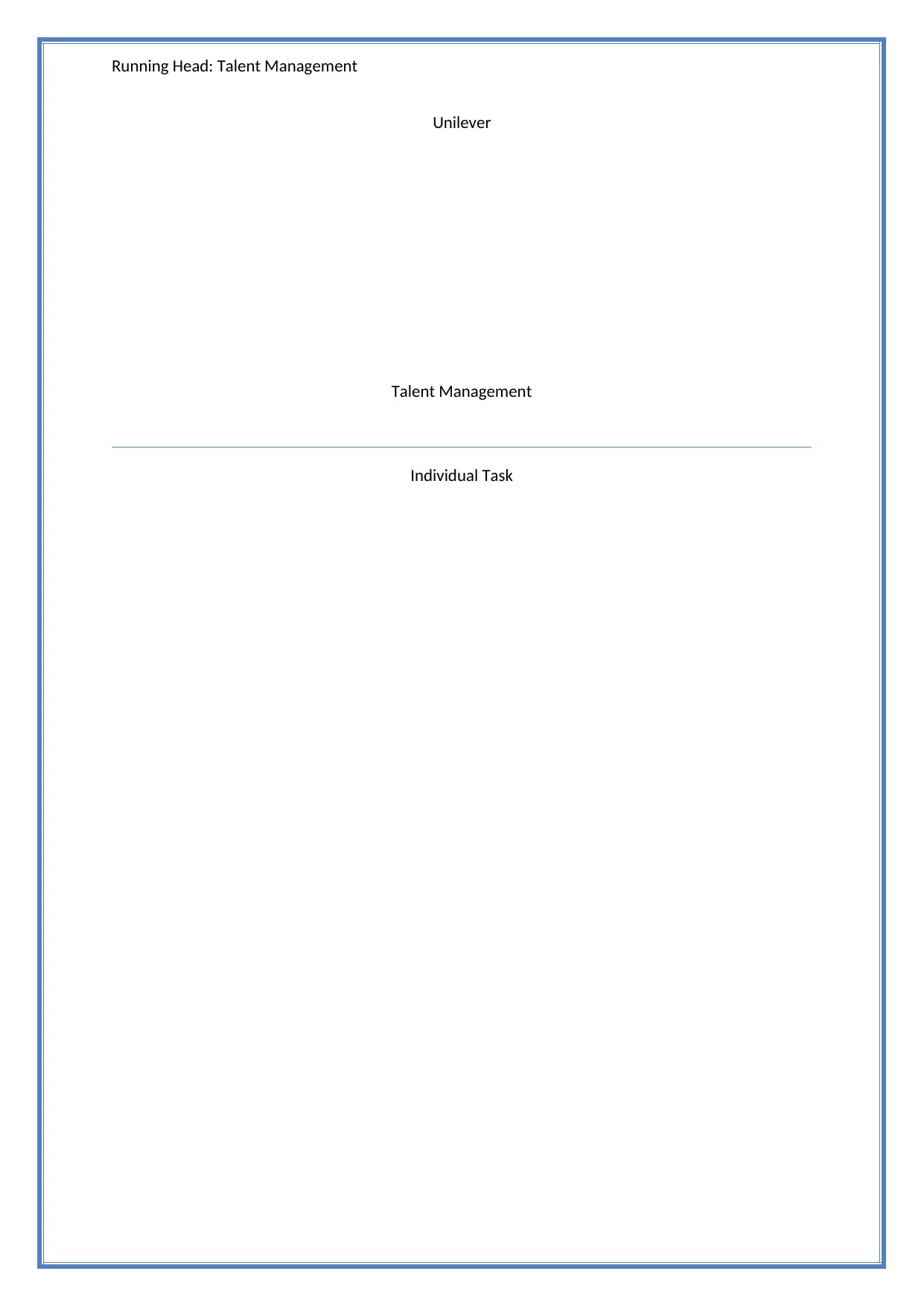
Running Head: Talent Management
Unilever
Talent Management
Individual Task
Unilever
Talent Management
Individual Task
Paraphrase This Document
Need a fresh take? Get an instant paraphrase of this document with our AI Paraphraser
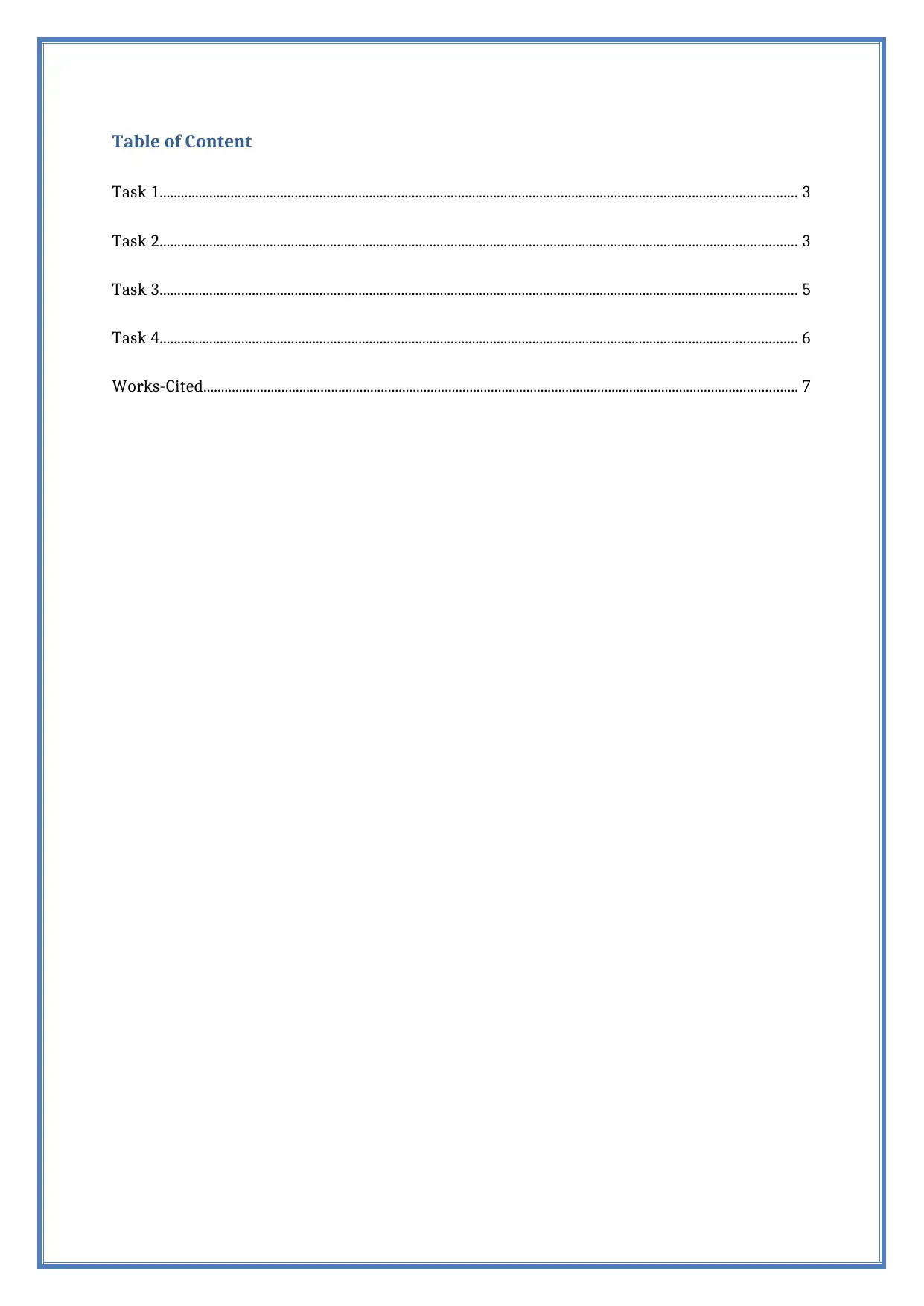
Table of Content
Task 1................................................................................................................................................................................... 3
Task 2................................................................................................................................................................................... 3
Task 3................................................................................................................................................................................... 5
Task 4................................................................................................................................................................................... 6
Works-Cited....................................................................................................................................................................... 7
Task 1................................................................................................................................................................................... 3
Task 2................................................................................................................................................................................... 3
Task 3................................................................................................................................................................................... 5
Task 4................................................................................................................................................................................... 6
Works-Cited....................................................................................................................................................................... 7
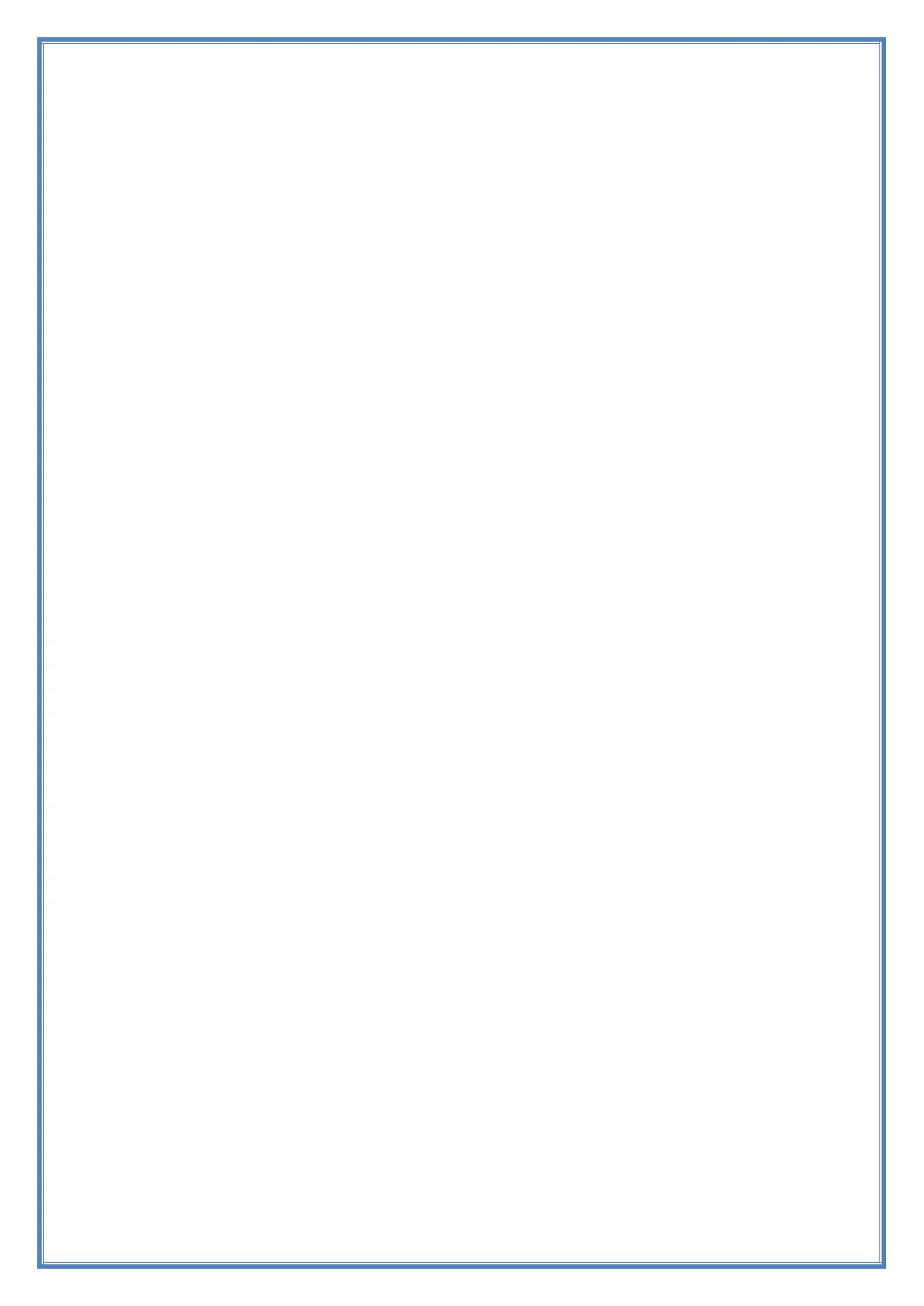
⊘ This is a preview!⊘
Do you want full access?
Subscribe today to unlock all pages.

Trusted by 1+ million students worldwide
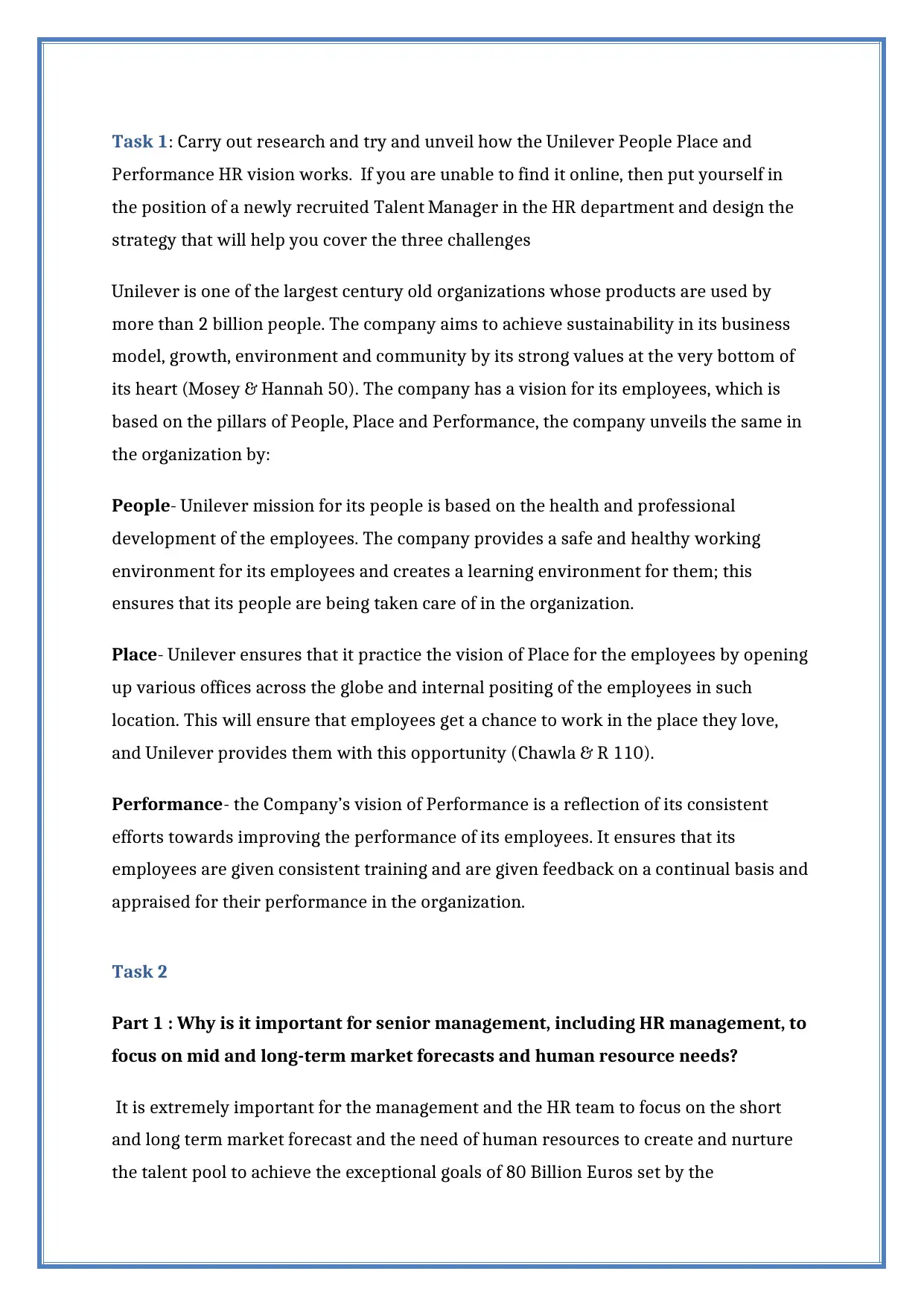
Task 1: Carry out research and try and unveil how the Unilever People Place and
Performance HR vision works. If you are unable to find it online, then put yourself in
the position of a newly recruited Talent Manager in the HR department and design the
strategy that will help you cover the three challenges
Unilever is one of the largest century old organizations whose products are used by
more than 2 billion people. The company aims to achieve sustainability in its business
model, growth, environment and community by its strong values at the very bottom of
its heart (Mosey & Hannah 50). The company has a vision for its employees, which is
based on the pillars of People, Place and Performance, the company unveils the same in
the organization by:
People- Unilever mission for its people is based on the health and professional
development of the employees. The company provides a safe and healthy working
environment for its employees and creates a learning environment for them; this
ensures that its people are being taken care of in the organization.
Place- Unilever ensures that it practice the vision of Place for the employees by opening
up various offices across the globe and internal positing of the employees in such
location. This will ensure that employees get a chance to work in the place they love,
and Unilever provides them with this opportunity (Chawla & R 110).
Performance- the Company’s vision of Performance is a reflection of its consistent
efforts towards improving the performance of its employees. It ensures that its
employees are given consistent training and are given feedback on a continual basis and
appraised for their performance in the organization.
Task 2
Part 1 : Why is it important for senior management, including HR management, to
focus on mid and long-term market forecasts and human resource needs?
It is extremely important for the management and the HR team to focus on the short
and long term market forecast and the need of human resources to create and nurture
the talent pool to achieve the exceptional goals of 80 Billion Euros set by the
Performance HR vision works. If you are unable to find it online, then put yourself in
the position of a newly recruited Talent Manager in the HR department and design the
strategy that will help you cover the three challenges
Unilever is one of the largest century old organizations whose products are used by
more than 2 billion people. The company aims to achieve sustainability in its business
model, growth, environment and community by its strong values at the very bottom of
its heart (Mosey & Hannah 50). The company has a vision for its employees, which is
based on the pillars of People, Place and Performance, the company unveils the same in
the organization by:
People- Unilever mission for its people is based on the health and professional
development of the employees. The company provides a safe and healthy working
environment for its employees and creates a learning environment for them; this
ensures that its people are being taken care of in the organization.
Place- Unilever ensures that it practice the vision of Place for the employees by opening
up various offices across the globe and internal positing of the employees in such
location. This will ensure that employees get a chance to work in the place they love,
and Unilever provides them with this opportunity (Chawla & R 110).
Performance- the Company’s vision of Performance is a reflection of its consistent
efforts towards improving the performance of its employees. It ensures that its
employees are given consistent training and are given feedback on a continual basis and
appraised for their performance in the organization.
Task 2
Part 1 : Why is it important for senior management, including HR management, to
focus on mid and long-term market forecasts and human resource needs?
It is extremely important for the management and the HR team to focus on the short
and long term market forecast and the need of human resources to create and nurture
the talent pool to achieve the exceptional goals of 80 Billion Euros set by the
Paraphrase This Document
Need a fresh take? Get an instant paraphrase of this document with our AI Paraphraser
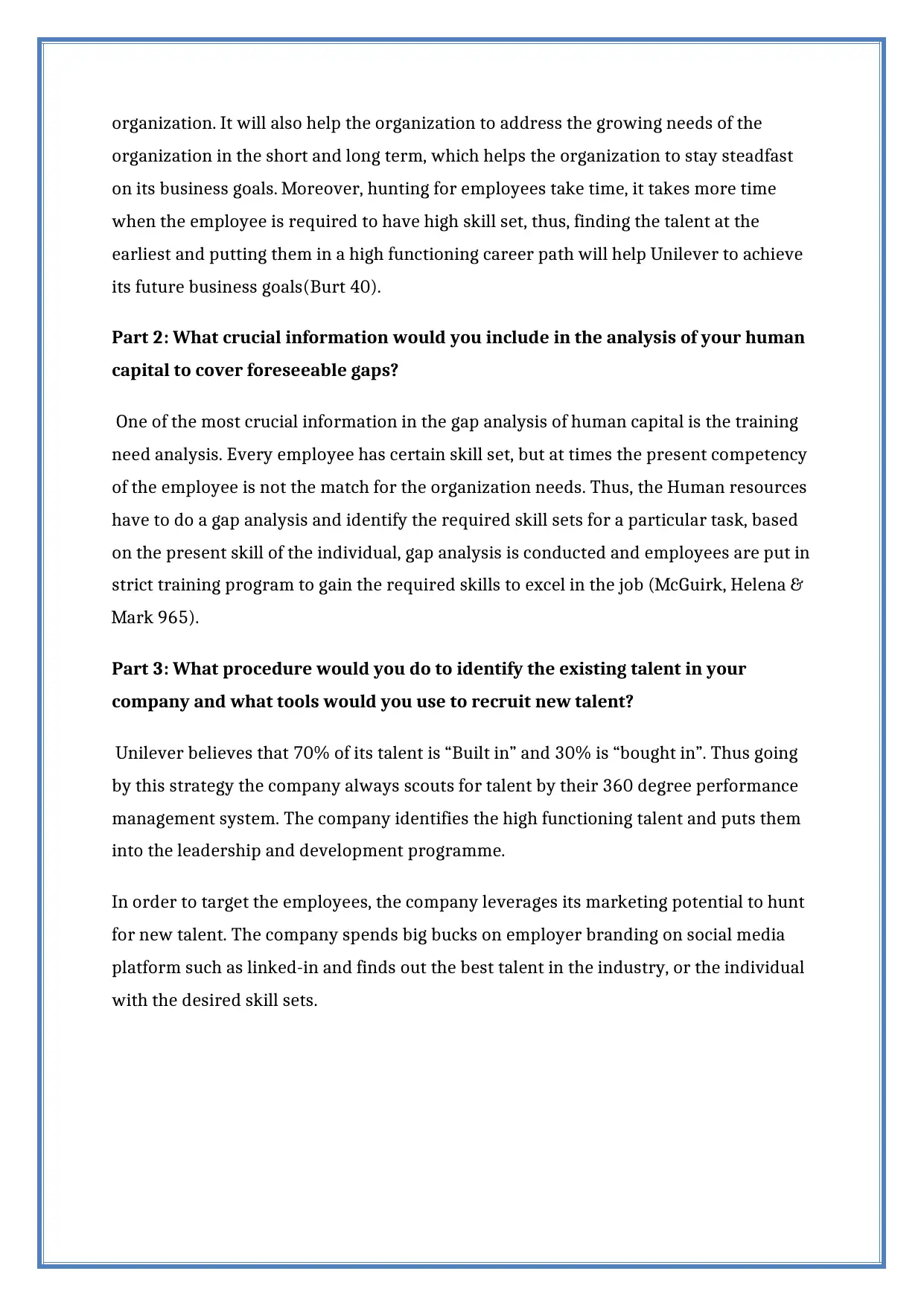
organization. It will also help the organization to address the growing needs of the
organization in the short and long term, which helps the organization to stay steadfast
on its business goals. Moreover, hunting for employees take time, it takes more time
when the employee is required to have high skill set, thus, finding the talent at the
earliest and putting them in a high functioning career path will help Unilever to achieve
its future business goals(Burt 40).
Part 2: What crucial information would you include in the analysis of your human
capital to cover foreseeable gaps?
One of the most crucial information in the gap analysis of human capital is the training
need analysis. Every employee has certain skill set, but at times the present competency
of the employee is not the match for the organization needs. Thus, the Human resources
have to do a gap analysis and identify the required skill sets for a particular task, based
on the present skill of the individual, gap analysis is conducted and employees are put in
strict training program to gain the required skills to excel in the job (McGuirk, Helena &
Mark 965).
Part 3: What procedure would you do to identify the existing talent in your
company and what tools would you use to recruit new talent?
Unilever believes that 70% of its talent is “Built in” and 30% is “bought in”. Thus going
by this strategy the company always scouts for talent by their 360 degree performance
management system. The company identifies the high functioning talent and puts them
into the leadership and development programme.
In order to target the employees, the company leverages its marketing potential to hunt
for new talent. The company spends big bucks on employer branding on social media
platform such as linked-in and finds out the best talent in the industry, or the individual
with the desired skill sets.
organization in the short and long term, which helps the organization to stay steadfast
on its business goals. Moreover, hunting for employees take time, it takes more time
when the employee is required to have high skill set, thus, finding the talent at the
earliest and putting them in a high functioning career path will help Unilever to achieve
its future business goals(Burt 40).
Part 2: What crucial information would you include in the analysis of your human
capital to cover foreseeable gaps?
One of the most crucial information in the gap analysis of human capital is the training
need analysis. Every employee has certain skill set, but at times the present competency
of the employee is not the match for the organization needs. Thus, the Human resources
have to do a gap analysis and identify the required skill sets for a particular task, based
on the present skill of the individual, gap analysis is conducted and employees are put in
strict training program to gain the required skills to excel in the job (McGuirk, Helena &
Mark 965).
Part 3: What procedure would you do to identify the existing talent in your
company and what tools would you use to recruit new talent?
Unilever believes that 70% of its talent is “Built in” and 30% is “bought in”. Thus going
by this strategy the company always scouts for talent by their 360 degree performance
management system. The company identifies the high functioning talent and puts them
into the leadership and development programme.
In order to target the employees, the company leverages its marketing potential to hunt
for new talent. The company spends big bucks on employer branding on social media
platform such as linked-in and finds out the best talent in the industry, or the individual
with the desired skill sets.
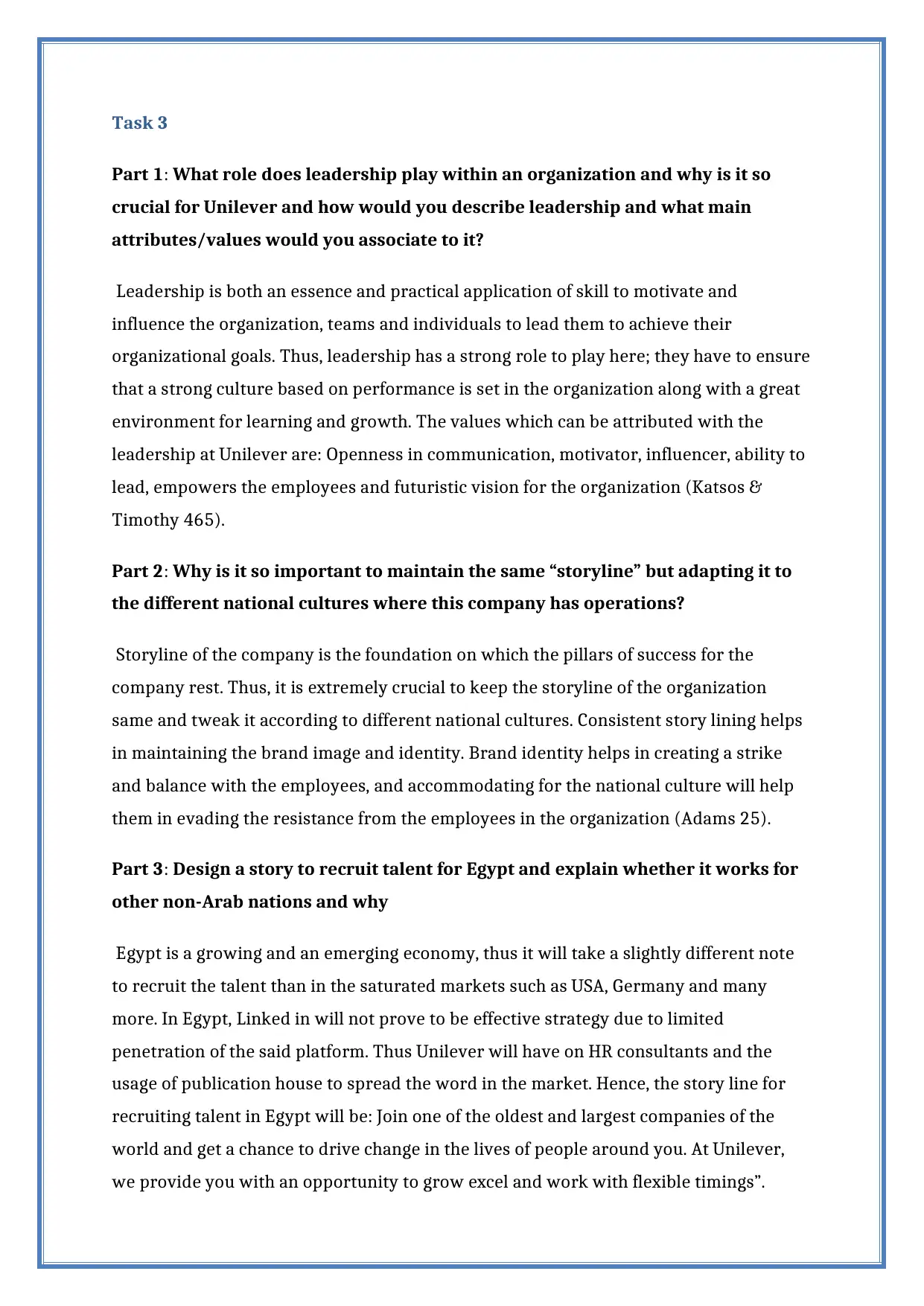
Task 3
Part 1: What role does leadership play within an organization and why is it so
crucial for Unilever and how would you describe leadership and what main
attributes/values would you associate to it?
Leadership is both an essence and practical application of skill to motivate and
influence the organization, teams and individuals to lead them to achieve their
organizational goals. Thus, leadership has a strong role to play here; they have to ensure
that a strong culture based on performance is set in the organization along with a great
environment for learning and growth. The values which can be attributed with the
leadership at Unilever are: Openness in communication, motivator, influencer, ability to
lead, empowers the employees and futuristic vision for the organization (Katsos &
Timothy 465).
Part 2: Why is it so important to maintain the same “storyline” but adapting it to
the different national cultures where this company has operations?
Storyline of the company is the foundation on which the pillars of success for the
company rest. Thus, it is extremely crucial to keep the storyline of the organization
same and tweak it according to different national cultures. Consistent story lining helps
in maintaining the brand image and identity. Brand identity helps in creating a strike
and balance with the employees, and accommodating for the national culture will help
them in evading the resistance from the employees in the organization (Adams 25).
Part 3: Design a story to recruit talent for Egypt and explain whether it works for
other non-Arab nations and why
Egypt is a growing and an emerging economy, thus it will take a slightly different note
to recruit the talent than in the saturated markets such as USA, Germany and many
more. In Egypt, Linked in will not prove to be effective strategy due to limited
penetration of the said platform. Thus Unilever will have on HR consultants and the
usage of publication house to spread the word in the market. Hence, the story line for
recruiting talent in Egypt will be: Join one of the oldest and largest companies of the
world and get a chance to drive change in the lives of people around you. At Unilever,
we provide you with an opportunity to grow excel and work with flexible timings”.
Part 1: What role does leadership play within an organization and why is it so
crucial for Unilever and how would you describe leadership and what main
attributes/values would you associate to it?
Leadership is both an essence and practical application of skill to motivate and
influence the organization, teams and individuals to lead them to achieve their
organizational goals. Thus, leadership has a strong role to play here; they have to ensure
that a strong culture based on performance is set in the organization along with a great
environment for learning and growth. The values which can be attributed with the
leadership at Unilever are: Openness in communication, motivator, influencer, ability to
lead, empowers the employees and futuristic vision for the organization (Katsos &
Timothy 465).
Part 2: Why is it so important to maintain the same “storyline” but adapting it to
the different national cultures where this company has operations?
Storyline of the company is the foundation on which the pillars of success for the
company rest. Thus, it is extremely crucial to keep the storyline of the organization
same and tweak it according to different national cultures. Consistent story lining helps
in maintaining the brand image and identity. Brand identity helps in creating a strike
and balance with the employees, and accommodating for the national culture will help
them in evading the resistance from the employees in the organization (Adams 25).
Part 3: Design a story to recruit talent for Egypt and explain whether it works for
other non-Arab nations and why
Egypt is a growing and an emerging economy, thus it will take a slightly different note
to recruit the talent than in the saturated markets such as USA, Germany and many
more. In Egypt, Linked in will not prove to be effective strategy due to limited
penetration of the said platform. Thus Unilever will have on HR consultants and the
usage of publication house to spread the word in the market. Hence, the story line for
recruiting talent in Egypt will be: Join one of the oldest and largest companies of the
world and get a chance to drive change in the lives of people around you. At Unilever,
we provide you with an opportunity to grow excel and work with flexible timings”.
⊘ This is a preview!⊘
Do you want full access?
Subscribe today to unlock all pages.

Trusted by 1+ million students worldwide
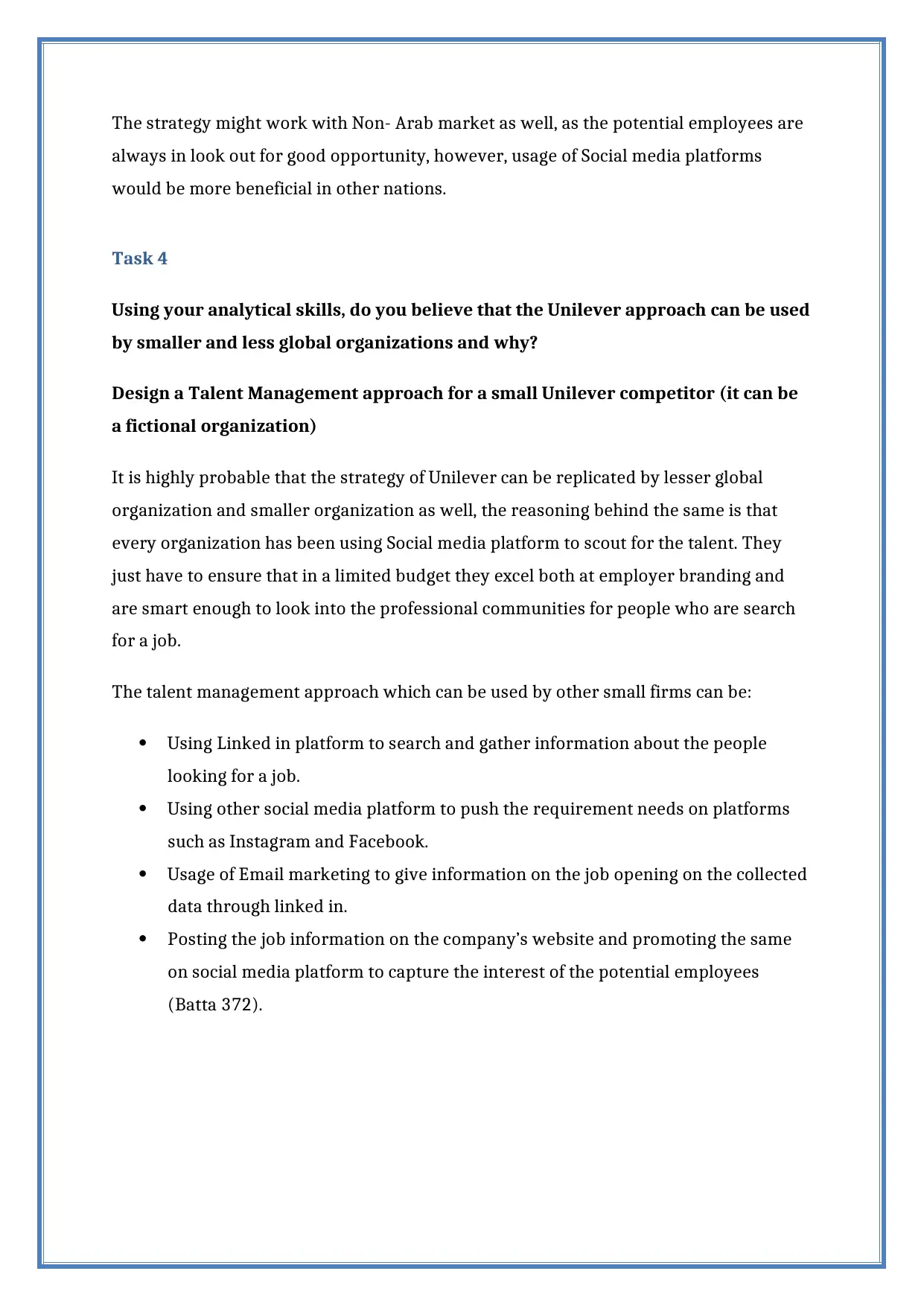
The strategy might work with Non- Arab market as well, as the potential employees are
always in look out for good opportunity, however, usage of Social media platforms
would be more beneficial in other nations.
Task 4
Using your analytical skills, do you believe that the Unilever approach can be used
by smaller and less global organizations and why?
Design a Talent Management approach for a small Unilever competitor (it can be
a fictional organization)
It is highly probable that the strategy of Unilever can be replicated by lesser global
organization and smaller organization as well, the reasoning behind the same is that
every organization has been using Social media platform to scout for the talent. They
just have to ensure that in a limited budget they excel both at employer branding and
are smart enough to look into the professional communities for people who are search
for a job.
The talent management approach which can be used by other small firms can be:
Using Linked in platform to search and gather information about the people
looking for a job.
Using other social media platform to push the requirement needs on platforms
such as Instagram and Facebook.
Usage of Email marketing to give information on the job opening on the collected
data through linked in.
Posting the job information on the company’s website and promoting the same
on social media platform to capture the interest of the potential employees
(Batta 372).
always in look out for good opportunity, however, usage of Social media platforms
would be more beneficial in other nations.
Task 4
Using your analytical skills, do you believe that the Unilever approach can be used
by smaller and less global organizations and why?
Design a Talent Management approach for a small Unilever competitor (it can be
a fictional organization)
It is highly probable that the strategy of Unilever can be replicated by lesser global
organization and smaller organization as well, the reasoning behind the same is that
every organization has been using Social media platform to scout for the talent. They
just have to ensure that in a limited budget they excel both at employer branding and
are smart enough to look into the professional communities for people who are search
for a job.
The talent management approach which can be used by other small firms can be:
Using Linked in platform to search and gather information about the people
looking for a job.
Using other social media platform to push the requirement needs on platforms
such as Instagram and Facebook.
Usage of Email marketing to give information on the job opening on the collected
data through linked in.
Posting the job information on the company’s website and promoting the same
on social media platform to capture the interest of the potential employees
(Batta 372).
Paraphrase This Document
Need a fresh take? Get an instant paraphrase of this document with our AI Paraphraser
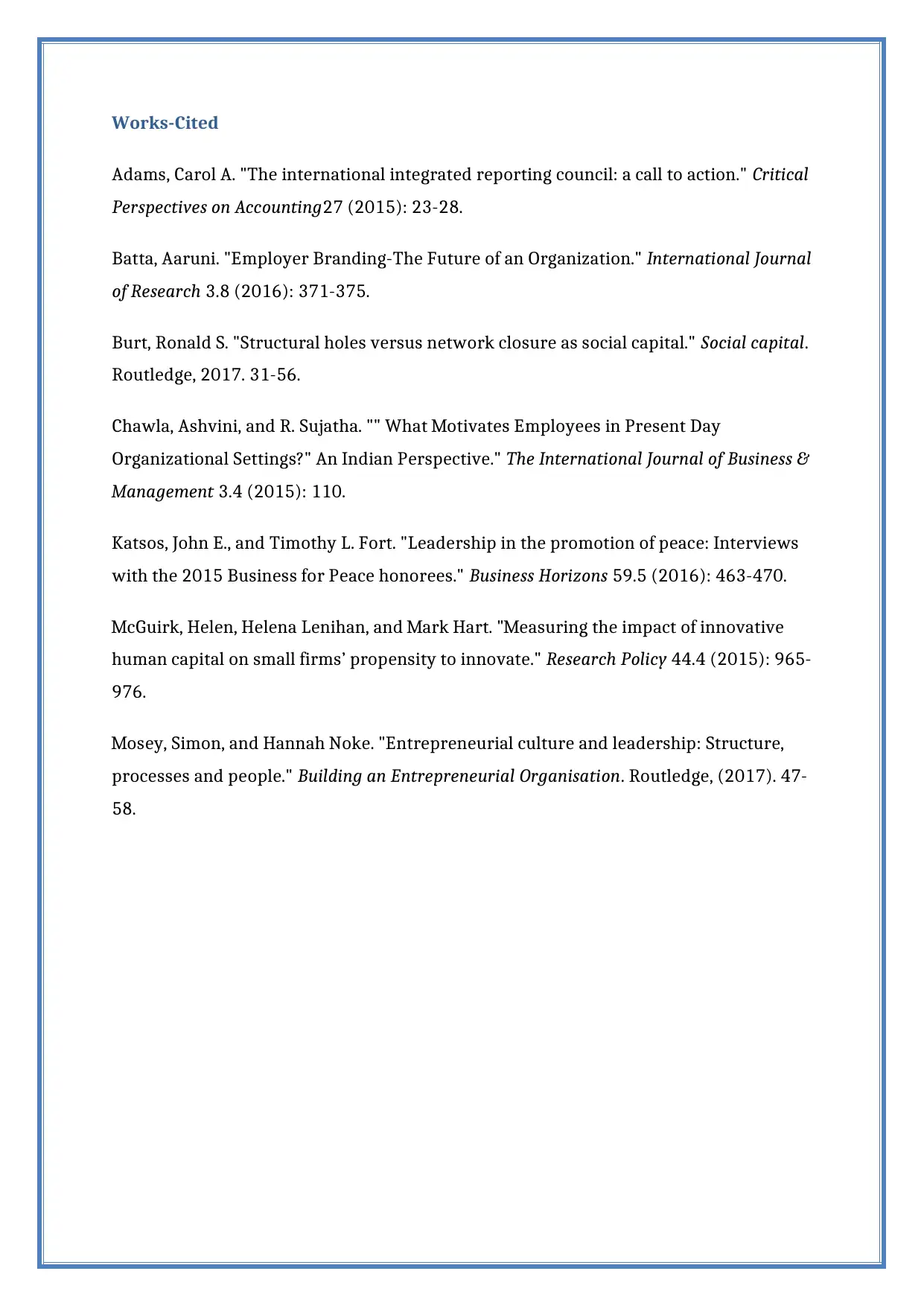
Works-Cited
Adams, Carol A. "The international integrated reporting council: a call to action." Critical
Perspectives on Accounting27 (2015): 23-28.
Batta, Aaruni. "Employer Branding-The Future of an Organization." International Journal
of Research 3.8 (2016): 371-375.
Burt, Ronald S. "Structural holes versus network closure as social capital." Social capital.
Routledge, 2017. 31-56.
Chawla, Ashvini, and R. Sujatha. "" What Motivates Employees in Present Day
Organizational Settings?" An Indian Perspective." The International Journal of Business &
Management 3.4 (2015): 110.
Katsos, John E., and Timothy L. Fort. "Leadership in the promotion of peace: Interviews
with the 2015 Business for Peace honorees." Business Horizons 59.5 (2016): 463-470.
McGuirk, Helen, Helena Lenihan, and Mark Hart. "Measuring the impact of innovative
human capital on small firms’ propensity to innovate." Research Policy 44.4 (2015): 965-
976.
Mosey, Simon, and Hannah Noke. "Entrepreneurial culture and leadership: Structure,
processes and people." Building an Entrepreneurial Organisation. Routledge, (2017). 47-
58.
Adams, Carol A. "The international integrated reporting council: a call to action." Critical
Perspectives on Accounting27 (2015): 23-28.
Batta, Aaruni. "Employer Branding-The Future of an Organization." International Journal
of Research 3.8 (2016): 371-375.
Burt, Ronald S. "Structural holes versus network closure as social capital." Social capital.
Routledge, 2017. 31-56.
Chawla, Ashvini, and R. Sujatha. "" What Motivates Employees in Present Day
Organizational Settings?" An Indian Perspective." The International Journal of Business &
Management 3.4 (2015): 110.
Katsos, John E., and Timothy L. Fort. "Leadership in the promotion of peace: Interviews
with the 2015 Business for Peace honorees." Business Horizons 59.5 (2016): 463-470.
McGuirk, Helen, Helena Lenihan, and Mark Hart. "Measuring the impact of innovative
human capital on small firms’ propensity to innovate." Research Policy 44.4 (2015): 965-
976.
Mosey, Simon, and Hannah Noke. "Entrepreneurial culture and leadership: Structure,
processes and people." Building an Entrepreneurial Organisation. Routledge, (2017). 47-
58.
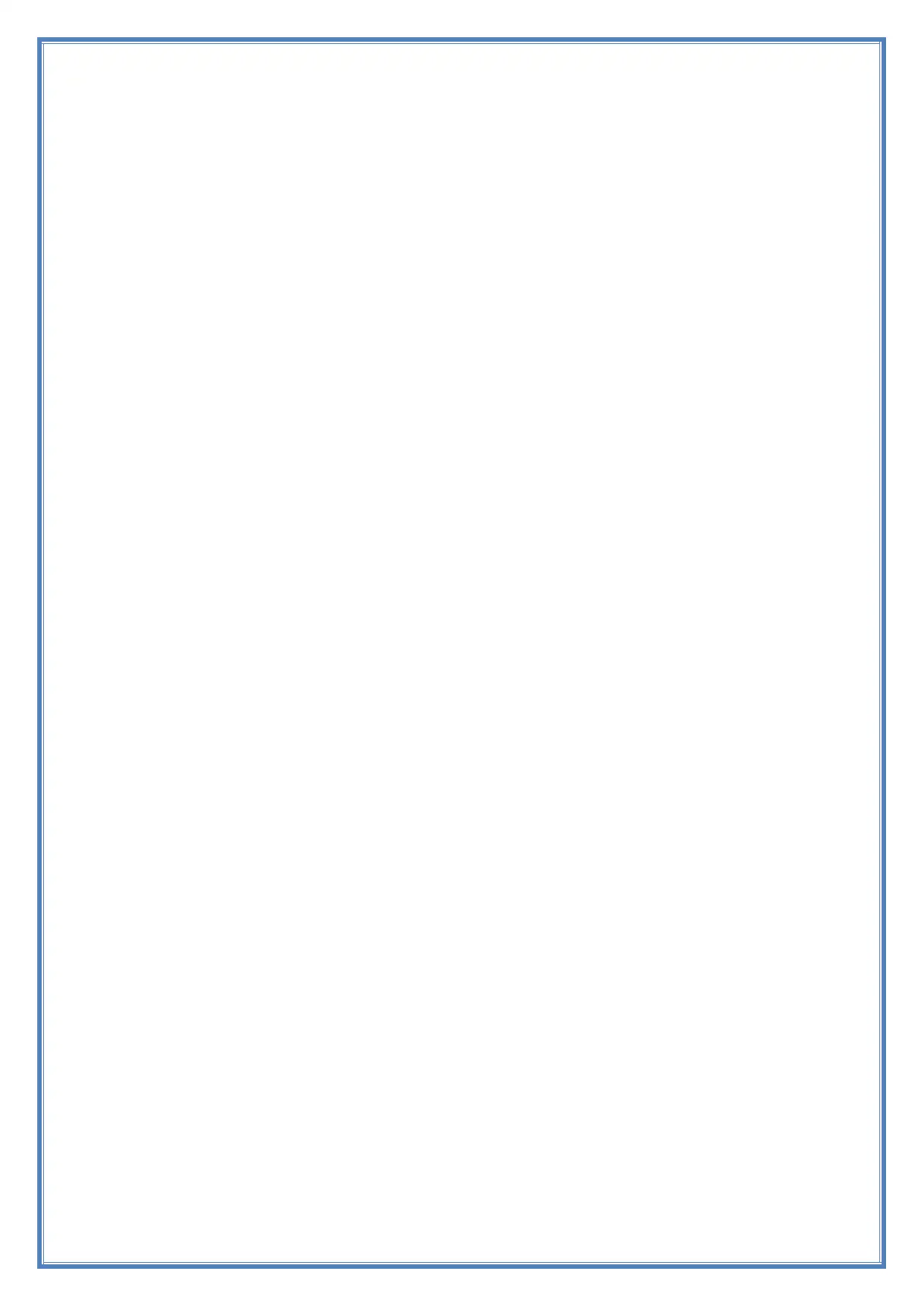
⊘ This is a preview!⊘
Do you want full access?
Subscribe today to unlock all pages.

Trusted by 1+ million students worldwide
1 out of 9
Related Documents
Your All-in-One AI-Powered Toolkit for Academic Success.
+13062052269
info@desklib.com
Available 24*7 on WhatsApp / Email
![[object Object]](/_next/static/media/star-bottom.7253800d.svg)
Unlock your academic potential
Copyright © 2020–2025 A2Z Services. All Rights Reserved. Developed and managed by ZUCOL.





